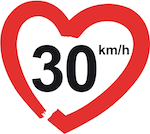The power of 30K speed limit
on Apr 22, 2013

30 kph has been proven to work in theory and in practice. Let’s make it a European priority to limit speeds in our cities, says the European Cyclists´ Federation (ECF).
ECF has been supporting and will continue to support the 30 kmh citizens’ initiative . The initiative seeks to force the European Commission to looking into the possibility of making 30 kph the default speed in urban areas.
There are many reasons why we are doing this and why, along with many other organisations across Europe, we support such a scheme.
Currently road speeds in European built-up urban areas are limited to around 50 kph though of course there are many exceptions where limits are lower. Recent analysis of cycle deaths in London found that virtually all fatal collisions occurred on roads with a speed limit of 48kph (30mph) or higher[1]. Excessive speed is a direct factor in about a fifth of all collisions and is a major contributory factor in a third of all road deaths.
The likelihood of a fatality when hit by a car at different speeds has also been estimated[2]:
- Hit at 40mph (64.4 kph), 90 per cent of pedestrians will be killed
- Hit at 30mph, (48.3 kph), 20 per cent of pedestrians will be killed
- Hit at 20mph, (32 kph), 3 per cent of pedestrians will be killed
The European Citizen Initiative: sign here for 30K as default speed limit in cities.
You already have signed? Make one friend sign then
30 kph works
A Norwegian study[3] has shown that a 10% reduction in the mean speed of traffic will result in a 37.8% reduction of the number of fatalities
The British Medical Journal[4] found that the introduction of 20mph zones (32 kph) over a twenty year period from 1986 – 2006 significantly improved road safety for users of all modes and ages. Particularly with regard to children, with children under 15 years old being killed and seriously injured reduced by half in areas where the speed limit is reduced to 20mph (32kph)
Looking specifically at one city Graz is the perfect example. Graz was the first city in Europe that introduced a city wide 30 kph zone. Around 800 km’s of a total 1000 km’s of city streets have been calmed[5]. The results? After the first 6 months there was a 24% reduction in serious accidents.
But what is also interesting is that the city had an increase in cycling and other active forms of transport.
Strong enforcement and implementation of 30 kph was important for this to work but seems to have provided real beneficial results without resorting to more expensive infrastructure. If the roads are free of fast moving traffic then this encourages more cyclists to get on their bikes while also providing a safer environment. The perception of risk was decreased as was the actual risk, both essential for cycling promotion.
This will become more important in how we find new and better ways to provide citizens with more liveable and sustainable cities and living environments. Our transport systems are and are going to play a pivotal role in this. It is our transport systems that are the biggest threat to our lives within urban areas. More than crime or fire or industrial accidents and yet it is also our transport systems that we depend on for everyday living.
30 kph can be a useful tool to deal with the motorised vehicles in urban and residential areas. There is no need to be doing any more than 30 kph, we need to put the emphasis on active forms of mobility to combat health problems, road safety issues, congestion and to provide more pleasant liveable areas to grow and live.
Sign our European Citizens´ Initiative “30 km/h – making streets liveable!”
Ceri Woolsgrove is ECF Policy Officer for Road Safety & Technical Issues. He is from the UK and has worked extensively in London, Brighton, Liverpool (UK), Hang Zhou (China) and now in Brussels. His previous employment was for an organisation representing the transport industry in Brussels. Ceri has a Master’s degree in Globalization and International Policy Analysis from the University of Bath, and Social and Political Thought from the University of Sussex
[1] Analysis of police collision files for pedal cyclists in London, 2001 – 2006, TFL http://www.trl.co.uk/online_store/reports_publications/trl_reports/cat_road_user_safety/report_analysis_of_police_collision_files_for_pedal_cyclists_in_london_2001___2006.htm
[2] Facts: Speed, Royal Society for the Prevention of Accidents, 2009 , in Braking point 20mph speed limits in London, April 2009 http://www.20splentyforus.org.uk/UsefulReports/braking-point-20mph.pdf
[3] Elvik, R et al (2004) Speed and road accidents: an evaluation of the Power Model https://www.toi.no/getfile.php/Publikasjoner/T%D8I%20rapporter/2004/740-2004/740-2004.pdf
[4] Effect of 20 mph traffic speed zones on road injuries in London, 1986-2006: controlled interrupted time series analysis, Grundy et al, British Medical Journal, Sep 2009. http://www.bmj.com/content/339/bmj.b4469.full
[5]Manfred Hoenig, The Graz traffic calming model and its consequences for cyclists, 2000, Department of transportation, City Council Graz http://www.velomondial.net/velomondiall2000/PDF/HONIG.PDF




No Comments
Trackbacks/Pingbacks